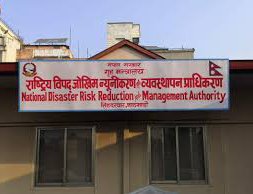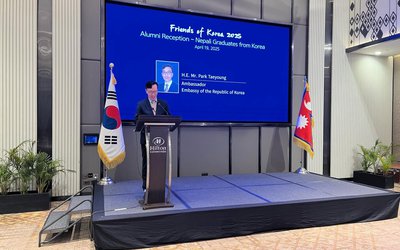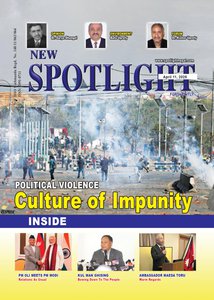
The National Disaster Risk Reduction and Management Authority (NDRRMA) was established in late 2019 and was widely welcomed by different partners and stakeholders of this field. A dedicated institution on DRRM is a common practice and is available in almost all countries of the world. Such institution, which is independent and autonomous is actively functioning in all countries of the SAARC region. At the regional level, SAARC Disaster Management Center (SDMC) is also operating having headquarter at Ahmedabad city in India. The need of such an institution is imperative to lead, coordinate and strengthen DRRM to build a safe and resilient Nepal.
In Nepal, the NDRRMA is functioning under the Ministry of Home Affairs and is responsible to manage and address all phases of DRRM in the country. To be effective, the NDRRMA must be an empowered agency and thus adopt a more holistic and integrated approach to disaster risk reduction and management. Disaster Management is a cross-cutting issue and hence demands different approach than the business as usual. Experience from other countries strongly suggest that NDRRMA Nepal should provide farsighted leadership in DRRM and offer practical and localized solutions in the field. It must also seek to find pragmatic, sustainable and resilient solutions through mobilization of all tiers of governments i.e., national, provincial and local governments including local communities in the field.
Besides, the NDRRMA must also regularly work with relevant stakeholders like; UN, donors, development partners, I/NGO, academic institutions, private sector, youth and volunteer groups, media, civil society, women association and others, at different stages of disaster risk reduction and management. The authority should maintain good rapport and network with international, national and local agencies and follows relevant global and regional conventions and protocols. This authority should optimally marshal the multi-sectoral and multi-stakeholders’ mandate, and hence coordinate and collaborate with different sectoral ministries and departments including specialized agencies to champion and mainstream DRRM into their regular plans and budgets. The present roles, responsibilities and authorities of NDRRMA closely acknowledges the spirit of Sendai Framework for DRR (2015-2030), which is presently the principal and guiding document of this sector. The role of NDRRMA is also central towards meeting Sustainable Development Goals (SDGs) targets and adapting to growing climate change concerns and challenges in the country.
The NDRRMA of Nepal is among the youngest in Asia and hence it should be able to take benefit from the network and experience of DRRM institution of other countries. The authority must act as a competent entity and should better align with the recent and explicit focus on risk reduction and risk transfer including growing use of communication and science and technological innovation in disaster management field. The SDGs goals and targets cannot be met unless disaster caused damages and losses are minimized and better coordinated. In this process, the NDRRMA must engage with all key partners and stakeholders and enhance their institutional capacities and build their human and material resources for effective planning and delivery of all phases of disaster risk reduction and management responsibilities- mitigation and prevention, humanitarian response, early recovery and recovery, reconstruction and development.
The NDRRMA Nepal will not be successful, unless it chooses the right approach to deal with the issues and challenges of continuously evolving DRRM sector in Nepal. The function of NDRRMA should be able to acknowledge and internalize the change in the governance system (from unitary to federal) and significant empowerment and delegation of all four phases of DRRM responsibilities to local governments. Mainstreaming disaster risk while working for risk friendly development should be the priority agenda of NDRRMA in Nepal. As a result, the country requires a truly comprehensive, holistic and integrated approach to DRRM, based on multi-hazard, risk reduction, inclusive and resilience building model.
In view of the above situation, NDRRMA needs a truly qualified and capable leadership, who is proficient and experienced in disaster risk reduction and management in Nepal. Experience and exposure of working in outside countries with international communities will help to bring and integrate global and regional knowledge and best practices to DRRM priorities in Nepalese context and realities. The multi-sectoral and multi-disciplinary approach to DRRM demands a leader with broad base and having sound knowledge and understanding of all phases of disaster management with focus to risk reduction, disaster preparedness, sustainable and inclusive development and resilience building concept. The head of authority is not a position of generalist (like General Manager post of many public corporations in Nepal) and it demands solid competency in multiple areas (administration, planning and management, coordination and networking, partnership and collaboration, training and capacity building, monitoring an evaluation, donors’ relation, fund raising and others) supported by sound technical knowledge and strong contextual background.
By virtue of its role, NDRRMA is expected to work with large range of international agencies including UN, donors, embassies, development partners and others and coordinate with them to benefit from their technical and financial supports on regular basis. In addition, the organization must work closely with all tiers of governments with priority to empowered local governments, who is now responsible for all phases of DRRM in Nepal. The leader must be experienced and skillful in working with multi-stakeholders and multi-disciplinary team and should be able to mobilize their support for putting collective efforts towards addressing rapidly increasing and evolving disaster management threats and challenges in Nepal. The leader should be able to effectively present country’s perspective in international forums and garner supports and raise funds for solving exponentially growing climate induced disaster risk challenges in Nepal.
The mounting climate change concern is making disaster incidents significantly devastating and lethal both in terms of human and economic losses in the country. It is difficult to minimize disaster risk and disaster losses in any country unless it is matter of every citizen’s concern and interest. Mass scale of awareness raising, and knowledge building is indispensable to make the subject of DRRM of everybody’s interest. This issue is very evolving, and it is always localized and therefore ‘blanket approach’ will not solve DRRM challenges in extremely diversified country like Nepal. Being a new organization, nurturing an appropriate system and building a smart institution is a priority agenda of NDRRMA. In this situation, a well acknowledged and experienced professional with strong background is indispensable to lead through the manifold priorities. The leader of NDRRMA therefore must have solid contextual knowledge and a strong perspective of DRRM in view of rugged topography, ecological adversity, rapid and unplanned urbanization, poverty, inequality and uneven development in the country. The organization need to work overtime and the leader must be on standby at all times to better manage these mammoth challenges by smartly maneuvering the opportunities and support of government of Nepal and external partners of this field.
Dr. Karna is an Urban Governance and DRR Specialist,The author can be reached at sumankarna@hotmail.com
- Missing On Early Warning – Pushed To Rising Death-Tolls And Losses Of Properties And Infrastructures
- Oct 07, 2024
- Building Climate Resilient Infrastructures - Way To Minimize Disasters Induced Damages And Losses
- Jun 21, 2023
- An Overview Of Early Warning System (EWS) In Nepal- How Inclusive And Resilient To Communities At Risk
- Oct 14, 2022
- Mainstreaming DRR And CCA Into Development Approaches- Indispensable To Secure SDGs Gains
- Jun 27, 2022
- Urban Resilience- A Growing Concern Of Urbanizing Nepal
- Aug 13, 2020














